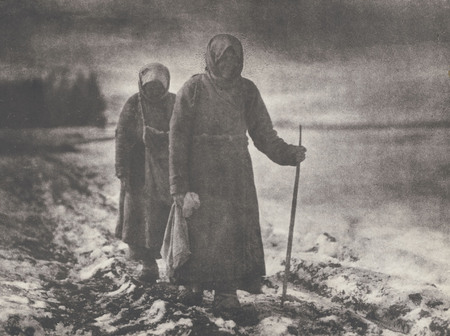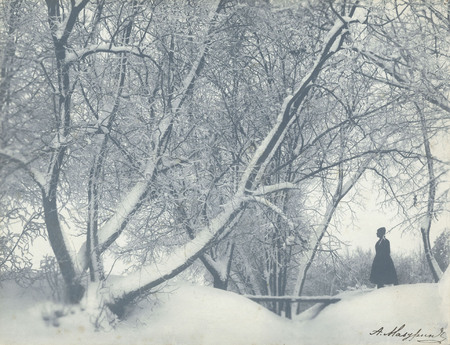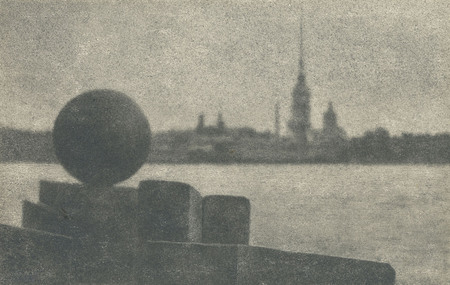Quiet Resistance, Russian Pictorial Photography, 1900—1930s





























Yuri Eremin. Summer. 1926. М. Golosovsky collection
Yuri Eremin. Herd. Mid-1920s. Moscow House of Photography Museum
Nikolai Andreev. Before the Storm. 1920s. Private collection
Nikolai Andreev. First Flowers. 1920s. Private collection
Nikolai Andreev. Moonlight. Panikovo. 1923. Private collection
Nikolai Andreev. Portrait of an Old Peasant. 1930. Private collection
Emil Bendel. Portrait of a Woman. 1910s. Moscow House of Photography Museum
Alexander Grinberg. Embankment. 1926. М. Golosovsky collection
Alexander Grinberg. Summer Sun. 1926. Union of Photo-artists of Russia collection
Pyotr Klepikov. Winter Study. 1923. Moscow House of Photography Museum
Pyotr Klepikov. Red Square. Moscow. 1940. Moscow House of Photography Museum
Pyotr Klepikov. Autumn. 1925. Moscow House of Photography Museum
Sergei Lobovikov. Housekeeper. 1909 – 1910. М. Golosovsky collection
Sergei Lobovikov. Visit to Granny. 1907 – 1908. М. Golosovsky collection
Sergei Lobovikov. Vagrant Russia. 1910s. Union of Photo-artists of Russia collection
Alexey Mazurin. Winter. 1900s. М. Golosovsky collection
Alexey Mazurin. Having a Stroll. 1898. М. Golosovsky collection
Nikolai Svishchov-Paola. Portrait of a Woman. 1920s. Union of Photo-artists of Russia collection
Nikolai Svishchov-Paola. Boat. 1920s. Moscow House of Photography Museum
Nikolai Svishchov-Paola. Leningrad. 1920s. Moscow House of Photography Museum
Sergey Savrassov. Moscow. Late 1910s. Union of Photo-artists of Russia collection
Sergey Savrassov. Over the Pond. 1900s. М. Golosovsky collection
Miron Sherling. Fedor Chaliapin as the Miller (in the opera “Rusalka” by Dargomyzhsky). 1913. М. Golosovsky collection
Leonid Shokin. On the Volga. Kimry. 1930s. Moscow House of Photography Museum
Leonid Shokin. Kimry. 1919. М. Golosovsky collection
Leonid Shokin. Peddler. 1920. М. Golosovsky collection
Anatoly Trapani. Portrait of a Man. 1917. Union of Photo-artists of Russia collection
Vasili Ulitin. Ships at Low Tide. 1926. М. Golosovsky collection
Vasili Ulitin. Portrait. 1930. М. Golosovsky collection
-
Somerset House,
London 28.11.2005 — 26.02.2006
About
Russian photo Avant-Garde of the 1920s—1930s — Alexander Rodchenko, El Lisitsky, Boris Ignatovich, etc. — suffered from the persecution and repressions of the totalitarian regime and later became a classic part of national and world art. Moreover, avant-garde was believed to symbolize the powerful energy and innovative vitality of the spirit of Soviet Russia in the several years following the October Revolution. However, it is little known that during the same period there existed a different movement in Russian photography — Pictorialis...
MoreRussian photo Avant-Garde of the 1920s—1930s — Alexander Rodchenko, El Lisitsky, Boris Ignatovich, etc. — suffered from the persecution and repressions of the totalitarian regime and later became a classic part of national and world art. Moreover, avant-garde was believed to symbolize the powerful energy and innovative vitality of the spirit of Soviet Russia in the several years following the October Revolution. However, it is little known that during the same period there existed a different movement in Russian photography — Pictorialism. Its adherents aspired to create photographs that would resemble painting, using soft lenses and special, sometimes very complicated, printing techniques. Pictorial photography was seen as opposing documentary shots, primarily aiming, just like painting, to introduce an emotional dimension into the work, to express the individual sensibility and meaning that its authors desired to convey. The masters of Russian Pictorial photography — Alexander Grinberg, Yuri Yeremin, Nikolai Andreev, Nikolai Svischov-Paola and others — could fit perfectly into the contemporary artistic landscape of the world. They received gold and silver medals at the most important photo exhibitions and salons in Europe, USA and Japan. Pictorialism, which universally appeared in the late 19th century, was by the mid-1920s in a state of crisis. But in Soviet Russia that decade brought a revival.
At the 1928 exhibition ‘Ten Years of Soviet Photography’ the so called ‘old school’ clearly outnumbered in terms of authors and works the modernists and adherents of the new Soviet reportage. Even though the thorough ideological purges regarding art, now forced to embrace the new aesthetic of Socialist Realism, began somewhat later (early and mid-1930s), it was that same year that Pictorial photographers were labeled as supporters of bourgeois ideology, ‘idealists-individualists’ and apologists of pre-revolutionary lifestyle.
This was true in the sense that Pictorial photographers, living in the new Soviet state, continued to work primarily influenced by universal values, desiring to express their personal existential and aesthetic experience. They felt little enthusiasm for the new Soviet slogans, which declared priority of the collective over the individual and demanded exalted laudation of ongoing revolutionary achievements.
Their works were usually limited to the traditional themes of international Pictorialism: landscape, the nude, shots of old country estates and simple genre scenes. A brilliant sense of composition and masterly technique made these photographers welcome guests at international exhibitions and salons. It is interesting to note that the foreign press, which wrote about them frequently and willingly, saw in their oeuvre, just like some of the critics in Russia, an example of aesthetic opposition to militant Soviet ideology.
Thus, one British photographic journal wrote, after a Paris salon of 1925, ‘The Russians, whatever their political convictions, in the shots they sent are firmly established within traditional boundaries’. Soviet critics fiercely attacked Pictorial photographers. They unsuccessfully urged them to pursue the only righteous path — Socialist Realism. It was based on the observation that ‘contemporary Soviet reality is such that laughter, joy and smiles are characteristic features of the new world’ and that ‘life became truly wonderful’ If in the late 1920s disputes about photography were primarily focused on aesthetic issues — advantages of a particular composition, different cameras or printing techniques, by the early 30s ideology begins to dominate. In the late 20s the authorities start hunting for the enemies of the revolution, a process which deeply influences all spheres of life, including photographic art. The ‘image of
the enemy’ becomes the basis of official propaganda. On the one hand, it helps paralyze with fear any individual capable of thinking or acting independently, on the other — it unites and inspires the masses to continue their heroic struggle in the name of the ‘bright future’. Pictorial photographers were, among many others, declared ‘enemies’. They were accused of nostalgia for
the old, pre-revolutionary world, in which there prevailed, in the eyes of the Soviet power, different, bourgeois values, instead of the class struggle theory. Landscapes, views of old country
estates and the female nude were blacklisted as ‘Turgenev’s sentimentalism’ and ‘political short-sightedness’.
However, the stronger the attack, the more stubborn the ‘quiet’ resistance. Working with themes ousted by official propaganda, pictorial photographers defended not just their own aesthetic, formed prior to the storms of the revolution, but their world outlook, which had little in common with the new Bolshevik mythology: ‘... With courage and calm I follow my path. As to changing
the course, it is very easy only for those, who regard the subject lightly’, — wrote Yuri Yeriomin.
After 1935 the authorities no longer limited themselves to moral persecution, but turned to repressive measures. Alexander Grinberg was sent to one of Stalin’s labor-camps with the absurd sentence of ‘distributing pornography’. The accusation appeared after the exhibition ‘Masters of Soviet Photography’ (1935), where the internationally renowned photographer showed his nude
sketches. At the same time the subject of the nude in photography was banned altogether. Vasili Ulitin was forced to move out of Moscow. Practically all Pictorialists were deprived of the right
to continue their creative work. By the end of the 1930s they were also no longer allowed to show their oeuvre abroad.
Despite all the repressive measures, Pictorial photographers remained loyal to their aesthetic. Yuri Yeremin, for example, would lock himself in the bathroom of his large communal flat and secretly print tiny copies of his favorite shots. Each one of these could have well served as sufficient evidence against him in court. In 1928 Alexander Rodchenko attacked Pictorialists in the magazine ‘New LEF’: ‘It is not that we are fighting against painting (it is dying anyway), but against photography ‘like painting’... It is our duty to experiment’4. However in the mid-30s, when Pictorialism was particularly unpopular with the authorities, he splendidly produced in that very manner his famous series ‘Circus’ and scenes of classical ballet and opera. Possibly this was also a sort of resistance... Tired of incessant revolutionary reforms that created reality far from the ideals that inspired his early works, Rodchenko wrote in his diary on 12 February 1943:
‘Art is serving the people, but the people are being led in different directions. What I want is to lead the people towards art, but not use art to lead someplace. Am I born early or late? One must separate art from politics...’
In the late 1930s Socialist Realism already dominated the artistic landscape, including photography. Divided from the rest of the world by the Iron Curtain, it later evolved from being ‘the most important art’ into just an accessory of the ideological machine. A large part of those original prints of the epoch, which did not comply with the new aesthetic, remaining in no demand and for some fifty years ousted from exhibitions, has now disappeared. The exhibition of Russian Pictorial photography, showing vintage prints, does not claim to give a detailed survey of the movement. It is more like a summary, an effort to outline its contours. For the first time it displays the works of a series of artists that lived in the same epoch and influenced one another.
Since the mid-1980s Russian Modernism and, particularly, the works of Alexander Rodchenko became increasingly popular abroad. Their ‘rediscovery’ in Russia took place only in the mid-
1990s. Russian Pictorial photography has only recently attracted the attention of specialists and historians of photography. A lot of work remains to be done. But even at its present stage it gives us a chance to understand better the development of Russian art and the country’s cultural history in the early 20th century.
Olga Sviblova
Museum collaborations
For further enquiries please contact
Julia Beigun
+7 (495) 637-11-22 ext. 218
beigun@mdf.ru


